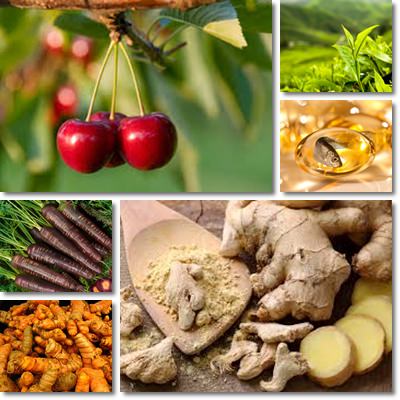Inflammation has been linked to the onset of many forms of chronic disease, from cardiovascular problems to diabetes, cancer and degenerative neurological disorders.
At its origin, inflammation is a normal biological response meant to signal a health problem, initiate tissue repair and healing.
However, the body’s inflammatory response can be perpetuated by various infelicitous factors and circumstances and gotten to the point where it ceases to be a symptom and becomes a cause for disease.
Our dietary habits are greatly responsible for either creating inflammation in our body or reducing it, hence the importance of diet in preventing disease.
The type of foods we consume, their low-quality or our poor choice of ingredients and even the very nature of certain foods or beverages may have a highly negative impact on our health as a whole. Luckily, there are just as many foods out there which can help lower inflammation levels and reduce its negative health effects as there are foods that create inflammation.
Counteracting excessive inflammation is pivotal for keeping healthy in the long run and eating right is a great way to do so. While we may respond differently to various foods, based on the principle of good for me but bad for you, there are some particular foods that benefit many of us in the sense that, when consumed in the right amounts and right way, they exert a strong anti-inflammatory action, engendering numerous positive health effects.
Below is my list of the 7 best anti-inflammatory foods to fight inflammation and boost health:

List Of 7 Foods That Fight Inflammation
1) Fish Omega-3
There are three types of Omega-3 fatty acids: ALA, EPA and DHA.
ALA (alpha-linoleic acid)
ALA is the one found in generous amounts in vegetable food sources such as walnuts or olive oil. It is extremely healthy, but not the healthiest of the three.
EPA (eicosapentaenoic acid) and DHA (docosahexaenoic acid)
EPA (eicosapentaenoic acid) and DHA (docosahexaenoic acid) are specific to animal food sources, fish being the richest. Of the three, DHA is the healthiest because it is physically present in a large percentage of our body in the brain, retina and skin.
Naturally, supplying our body with this crucial nutrient is vital for brain and nervous system health.
As a result of its strong anti-inflammatory properties, Omega-3 from animal sources has been shown to nourish the brain, reduce the effects of stress, combat mental fog (also known as brain fog), prevent neurological decline in the elderly, reduce inflammation at the level of the lungs and digestive system in particular, with lower risks for stomach and colon cancer, as well as improve asthma and arthritis symptoms as well as skin appearance, delaying wrinkles.
Considering that fish Omega-3 fatty acids are our brain’s favorite type, salmon, tuna, sardines, herring, mackerel, halibut, swordfish and cod as well as other seafood are the healthiest options for us.
But aren’t nuts, eggs and meat healthy too?
After all, they all contain Omega-3. They are all healthy foods, well, as long as eggs and meat are consumed in moderate amounts. However, if you are looking for the formula with the strongest anti-inflammatory effect, then fish is the best option by far because of its high concentrations of the fatty acid.

2) Turmeric (Curcuma longa).
Turmeric is one of the healthiest spices available. In addition to potent cancer-fighting, antiviral, antifungal and antioxidant properties, turmeric boasts an excellent anti-inflammatory action.
Research suggests that curcumin, the main active compound in turmeric, directly inhibits several molecules responsible for triggering inflammation, hence its strong anti-inflammatory action.
Even more, studies show that taking curcumin supplements, which provide higher amounts of the active ingredient that we can possibly get from dietary sources, is safe for use over extended periods of time.
Turmeric is also extremely versatile that we can add it to virtually any recipe, from rice and chicken dishes to vegetable stews, stir-fries, purees and soups.
Nevertheless, no food is universally healthy so know that curcumin in turmeric can act as a mild irritant and cause side effects in people with digestive disorders such as gastritis and acid reflux, so watch your turmeric intake if you have gastritis.
3) Vitamin C-rich foods
Including as much vitamin C rich foods in our diet as possible is a great way to fight inflammation naturally.
Strawberries, kiwifruit, raw bell peppers, unripe mirabelles, lemons, oranges and other citrus fruit are the best and most readily available options when it comes to getting vitamin C from food sources.
Fun fact: the presence of vitamin C in food is generally indicated by a sour taste (although natural acids such as malic acid or citric acid are what make fruits, even ripe ones, taste acidic).
If your strawberries have slight sour flavor notes, then they are likely to contain good amounts of vitamin C. If they are too sweet or overripe, they may have lost some of their vitamin C content.
Moreover, as research suggests, our body requires far greater amounts of vitamin C than the recommended daily allowance of only 90 mg, which means supplementation might be necessary.
The utter lack of taste or smell of food in general has been associated with extremely low levels of nutrients because, despite what we might be told, nutrient value may vary considerably within the same foods primarily as a result of differences in soil quality.
Essentially, you can tell if a fruit or vegetable is nutritious based on how well it retains flavor and smell. A strawberry with a neither sweet nor sour taste will not be as nutritious as one with a sweet taste and sharp, acidic flavors.
So beware of artificial foods with no taste and no smell: they are likely less nutritious than they should be and thus provide inferior nourishment.
4) Green tea (Camellia sinensis)
Green tea is one of the most popular hot beverages in the world and much of its popularity stems from its high antioxidant value shown to promote good health, reduce the risk of chronic illnesses and even increase lifespan.
The specific antioxidant compounds in green tea (flavonoids, particularly catechin) boast excellent anti-inflammatory properties as well, hence the overall improved health of regular green tea consumers.
Nevertheless, green tea is a generous source of caffeine, a highly stimulant compound also found in coffee.
Caffeine might exert mild negative health effects on certain people, particularly those with existent cardiovascular conditions.
Side effects of excessive caffeine intake may include heart palpitations, arrhythmia (extrasystoles, palpitations), rise in blood pressure, but also dizziness or lightheadedness, insomnia, agitation, increased anxiety and nervousness.
5) Ginger (Zingiber officinale)
A relative of turmeric, ginger is another great anti-inflammatory food with an overall positive impact on human health.
In addition to cardiovascular benefits, ginger has been shown to reduce inflammation at the level of the gastrointestinal tract, contribute to cancer prevention as a result of biologically active compounds such as gingerols, shogaol, and paradols and improve muscle pain and aches following intense physical exercise.
Ginger can be added to herbal infusions to improve taste or any dish that lends itself to spiciness. I like to add a half of tablespoon of ginger powder to a big glass of fruit juice every morning and leave turmeric for my favorite recipes.
However, as healthy as it may be, ginger should be consumed with moderation. Its spiciness can easily irritate an already sensitive stomach mucosa (gastritis sufferers, beware) as well as hemorrhoids, causing them to swell and become quite painful (see more reasons not to eat ginger).
6) Cherries (Prunus avium)
According to research, sweet cherries contain biologically active compounds that inhibit the COX (Cyclooxygenase) enzyme responsible for triggering inflammation and pain.
It would appear that the anthocyanins that give the fruit their beautiful red color are the ones responsible for their potent anti-inflammatory effect.
Studies have shown that regular consumption can help improve arthritis and gout pain as well as reduce muscle soreness following intense physical exercise.
Other studies have shown that regular consumption of the fruit reduces C-reactive protein levels visibly (CRP is an inflammation marker).
It has been suggested that the more cherries we eat, the more pronounced their anti-inflammatory effects would be. And since they do not have any side effects, cherries are a great long-term, safe option for the management of pain.
Sour cherries possess similarly strong anti-inflammatory properties and both cherry and sour cherry juice are just as good for our health as the fresh fruit. See benefits of sour cherries.
7) Black carrots (Daucus carota sativus)
Black carrots are not really black but rather various shades of dark purple or indigo. And it is their color that makes them so healthy.
Black carrots contain anthocyanins, pigments with both antioxidant and anti-inflammatory properties.
Including purple carrots in our diet can help prevent and improve painful inflammatory conditions and prevent related long-term side effects. However, it is important to note that the carrots are best consumed raw to prevent them from losing important nutrients.
Conclusion
Including as many of these foods as possible into our diet on a regular basis can not only up our intake of important nutrients, but also improve our health immensely in the long run. The biologically active anti-inflammatory compounds responsible for reducing swelling and associated pain will exert a beneficial action on the cardiovascular and digestive systems as well as offer antioxidant protection to cells throughout our body, slowly working from the inside towards better health and providing protection against chronic disease.
